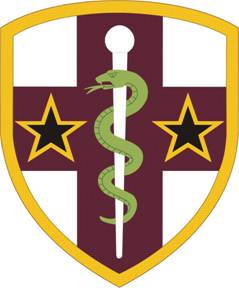This article's lead section may need to be rewritten. The reason given is: Remove the military-speak and rewrite with less huff-and-puff.(March 2022) |
| Army Reserve Medical Command | |
|---|---|
 | |
| Branch | US Army Reserve |
| Reserve center | Pinellas Park, Florida |
| Motto | "Soldiers First" |
| Medical Corps colors | Maroon and white |
| Commanders | |
| Current commander | MG Michael L. Yost |
| Insignia | |
| Distinctive unit insignia |  |
The Army Reserve Medical Command (AR-MEDCOM) provides command and control for table of distribution and allowance (TDA) reserve medical units within the contiguous United States. Army Reserve Medical Command headquarter is located at the CW Bill Young Armed Forces Reserve Center in Pinellas Park, Florida.
Contents
- Organization
- History
- List of commanders
- Unit insignia
- Shoulder sleeve insignia (SSI)
- Distinctive unit insignia (DUI)
- References
- External links
Reserve Table of Organization and Equipment (TOE) medical units and formations are commanded by the 807th MDSC, which covers west of Ohio, and the 3rd MDSC covers units to the east of Ohio.
Army Reserve Medical Command is responsible for all table of distribution and allowance (TDA) reserve medical units within CONUS. [1] In 1990 the Army Reserve maintained 24 Table of Distribution and Allowances (TDA) hospitals, designed to augment 'existing Army hospitals' in the Continental United States. [2] At that time they included the 1125th (Devens); 1207th (Benning); 1208th U.S. Army Hospital (Fort Monmouth); 2289th Army Hospital (Fort Dix); 2290th at Walter Reed; 2291st at Fort Gregg-Adams; 3270th at Fort Jackson; 3271st at Fort Stewart; 3273rd at Fort Campbell; 3274th at Fort Bragg; 3297th at Fort Gordon; 3343rd at Redstone Arsenal; 3344th at Fort Novosel; 3345th at Fort McClellan; 4005th at Fort Cavazos; 4010th, 5010th; 5501st; 5502nd; 5503rd; 6250th; 6251st; 6252nd at Fort Ord; and 6253rd Army Hospital at Fort Carson.






